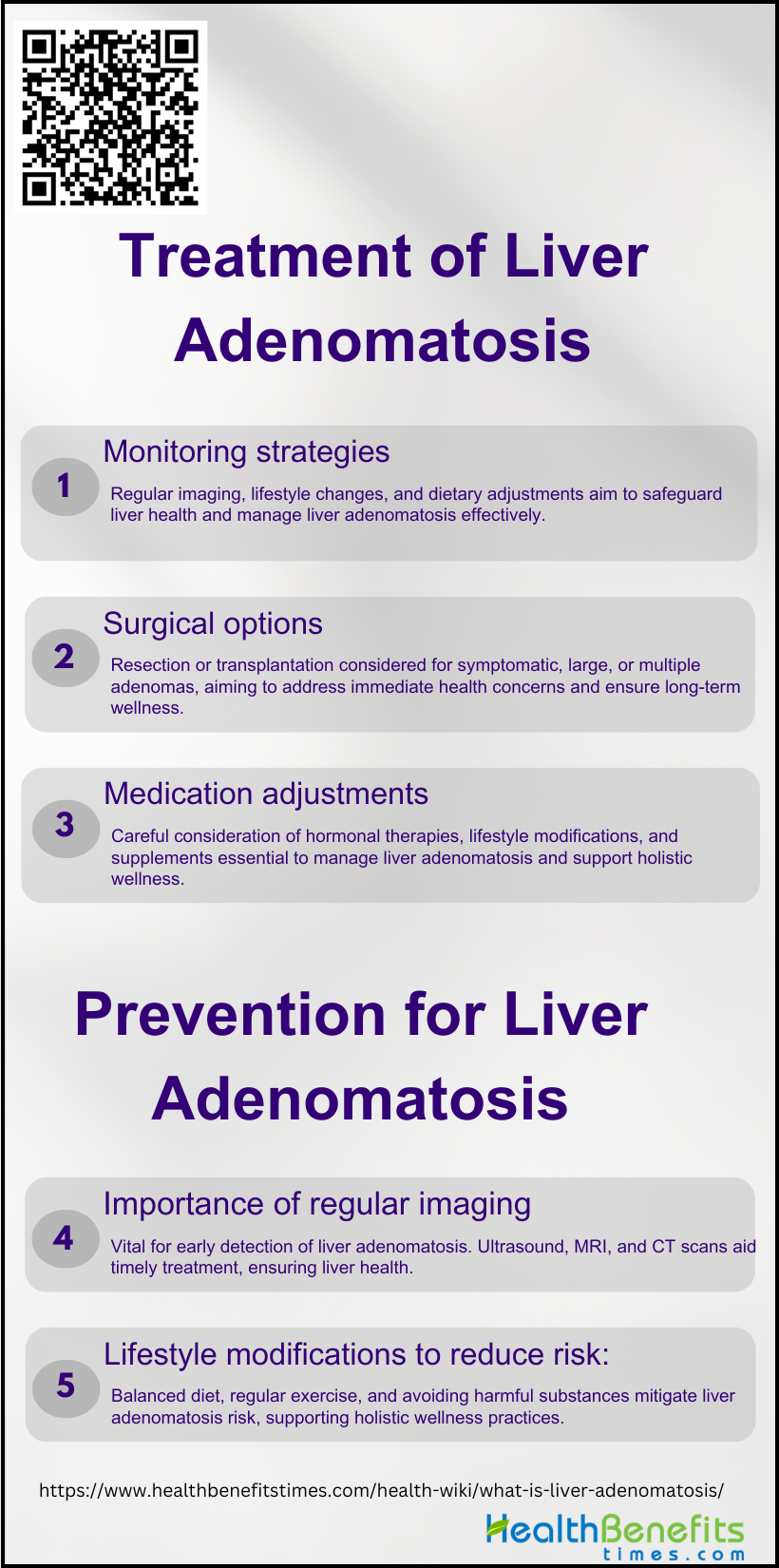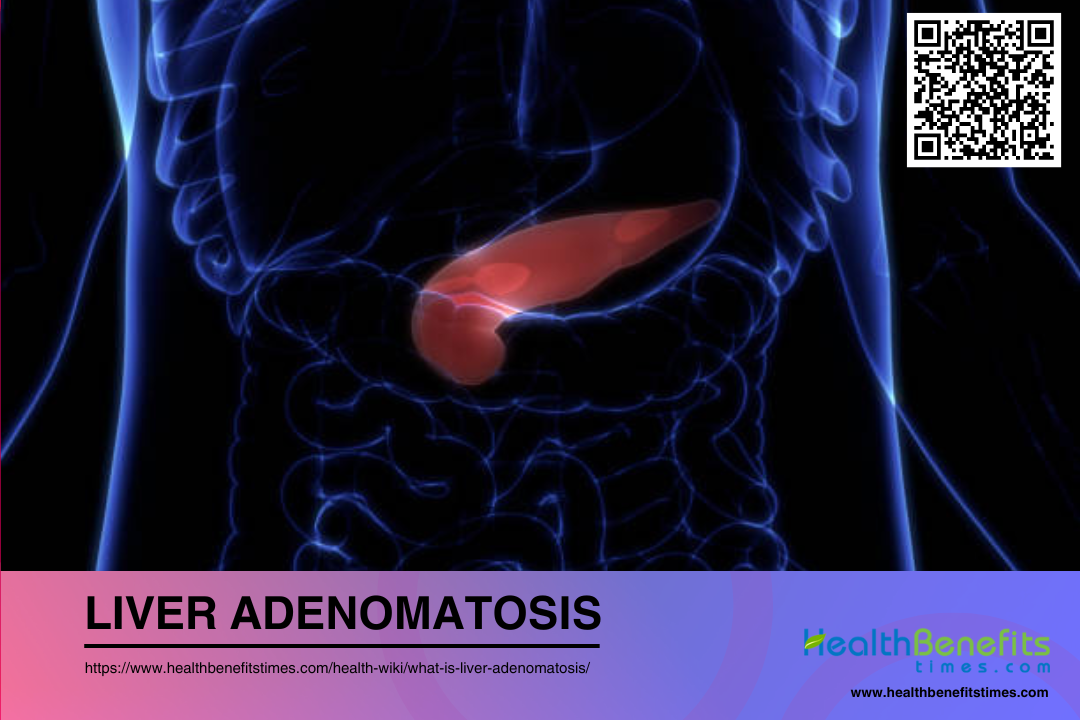 Liver adenomatosis, also known as hepatic adenomatosis, is a rare condition marked by the development of multiple benign liver tumors called adenomas. These tumors usually go unnoticed until they become large or numerous, often being detected by chance during imaging for other health concerns. More common in women and frequently linked to oral contraceptive use, this condition requires careful monitoring and personalized care to prevent serious complications like bleeding or cancerous changes. Emphasizing the need for regular health check-ups and a proactive stance on health, liver adenomatosis highlights the importance of individualized attention in maintaining liver health and overall wellness, a critical aspect of holistic health practices.
Liver adenomatosis, also known as hepatic adenomatosis, is a rare condition marked by the development of multiple benign liver tumors called adenomas. These tumors usually go unnoticed until they become large or numerous, often being detected by chance during imaging for other health concerns. More common in women and frequently linked to oral contraceptive use, this condition requires careful monitoring and personalized care to prevent serious complications like bleeding or cancerous changes. Emphasizing the need for regular health check-ups and a proactive stance on health, liver adenomatosis highlights the importance of individualized attention in maintaining liver health and overall wellness, a critical aspect of holistic health practices.
Types of Liver Adenomatosis
Understanding the various types of Liver Adenomatosis is crucial for early detection and effective management of these conditions. Below, we delve into the different classifications of liver adenomatosis, each with its unique features and implications for holistic health and wellness.
1. Inflammatory
Inflammatory liver adenomatosis, a condition marked by liver tumors with inflammatory cells, is notable for its systemic implications, including associations with metabolic disorders like obesity and metabolic syndrome. Patients may experience systemic symptoms such as fever and malaise due to an overproduction of inflammatory proteins, with these adenomas posing a higher risk of bleeding and potential malignancy. Elevated markers such as C-reactive protein and serum amyloid A indicate the body’s inflammatory response. Inflammatory hepatocellular adenomas (IHAs) are a subtype of liver adenomatosis characterized by the activation of the interleukin-6 pathway, leading to high expression of C-reactive protein and serum amyloid A. Holistic health practices underscore the importance of recognizing the links between liver health and systemic inflammation. Early detection, dietary and lifestyle adjustments, stress management, and consistent medical evaluations are integral to managing this condition. Consulting healthcare professionals is essential to create personalized care plans for optimal health outcomes.
2. HNF-1 inactivated
The HNF-1α inactivated hepatic adenomas, or H-HCA, are a notable subtype of benign liver tumors with a reduced likelihood of becoming cancerous. Liver adenomatosis is characterized by multiple adenomas within normal hepatic parenchyma, often associated with hepatocyte nuclear factor-1 alpha (HNF-1α) inactivation. These tumors arise from mutations in the HNF1A gene, which is integral to liver function and metabolism. Notably, they present with a fatty appearance on scans and are linked to metabolic issues like maturity-onset diabetes of the young (MODY) when hereditary mutations are involved. While generally exhibiting a benign behavior, there’s a risk of bleeding in about 15% of cases. For health practitioners, a deep understanding of H-HCA is vital to guide diagnosis, manage treatment effectively, and prevent serious complications, ensuring a comprehensive approach to liver wellness.
3. Beta-catenin activated
Beta-catenin activated hepatocellular adenomas (HCAs) are a notable subtype of liver tumors with a heightened risk of becoming cancerous, necessitating vigilant monitoring and possibly surgical intervention. Beta-catenin activated liver adenomatosis is a subtype of hepatic adenoma with a high risk of malignant transformation. These tumors are marked by specific mutations in the beta-catenin gene, leading to its abnormal buildup in cells and increasing the likelihood of malignant transformation. While less common, their significance is underscored by links to male hormone treatments, certain genetic conditions, and familial adenomatous polyposis. Embracing a holistic health approach, it’s essential to integrate regular health checks, a nutritious diet, and lifestyle adjustments to support liver well-being and reduce the risks tied to this condition.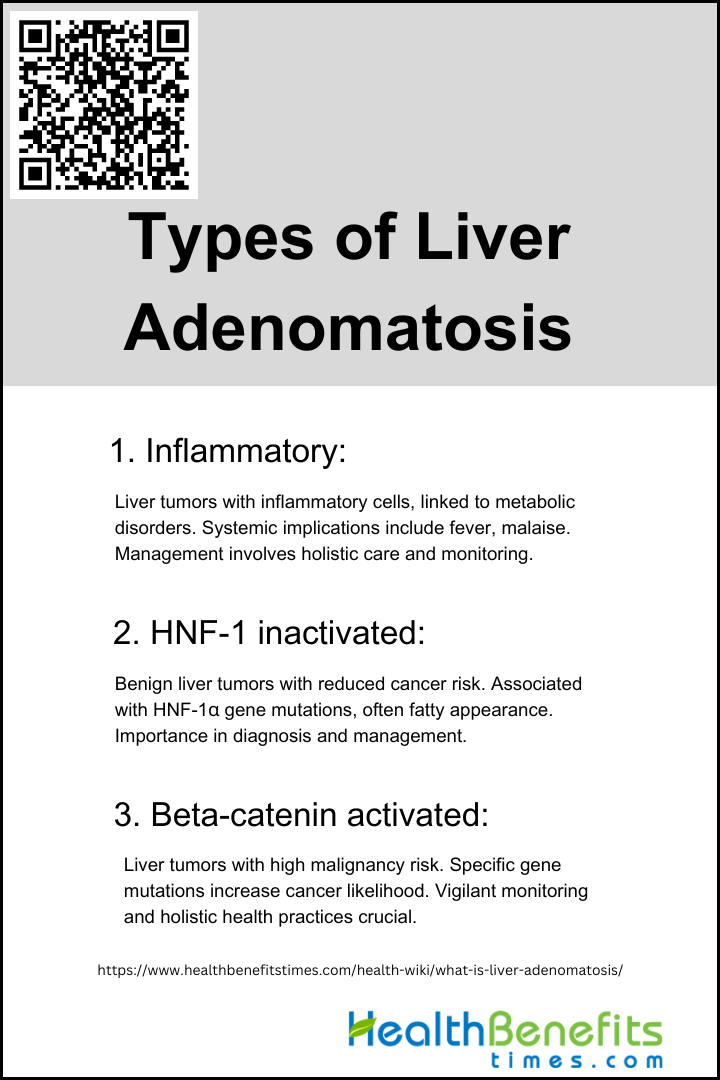
Causes of Liver Adenomatosis
Understanding its causes is crucial for both prevention and management. In the following list, we delve into the various factors that contribute to the development of liver adenomatosis, offering insights into this complex health issue.
1. Birth control pills
Oral contraceptives, especially those with high estrogen levels, have been linked to liver adenomatosis, a condition marked by the growth of benign liver tumors. Estrogen in these pills may encourage the proliferation of liver cells and reduce cell death, potentially increasing the chance of tumor development. The risk escalates with long-term use, making it vital for individuals prioritizing a holistic health and wellness lifestyle to carefully weigh the pros and cons of various birth control options with their healthcare provider. Regular medical check-ups are recommended for those on oral contraceptives to monitor liver health and address any concerns promptly, as large or ruptured adenomas can pose serious health threats.
2. Pregnancy
Pregnancy is a significant physiological state where the body undergoes numerous hormonal changes, some of which can influence liver health. Pregnancy can lead to liver adenomatosis through various pregnancy-related liver diseases. During this time, elevated levels of estrogen and progesterone can lead to the development of liver adenomatosis, a condition characterized by the benign proliferation of liver cells. Although relatively rare, these hormone-induced liver adenomas are more commonly observed in women of childbearing age, particularly those with a history of long-term oral contraceptive use, which similarly elevates hormone levels. It is crucial for expectant mothers to monitor their liver health and consult healthcare providers for regular check-ups, as these adenomas can increase in size during pregnancy, potentially leading to complications. Holistic health approaches emphasize the importance of balanced nutrition and stress management during pregnancy to support overall liver function and well-being.
3. Anabolic steroids
Anabolic steroids, artificial forms of testosterone, are often used to boost muscle growth and sports performance but pose a serious threat to liver health, particularly with the risk of liver adenomatosis. This condition involves the growth of benign liver tumors, which can disrupt liver function and regeneration, especially with long-term or high-dose steroid use. Symptoms may include abdominal pain or masses, and in severe cases, life-threatening bleeding or cancerous changes. The holistic health community warns against the misuse of steroids due to these dangers and promotes natural ways to achieve fitness and wellness goals, underlining the importance of protecting liver health and overall well-being.
4. Clomiphene
Clomiphene, a drug often prescribed to induce ovulation and treat infertility, has been linked to the rare but significant risk of liver adenomatosis, a condition marked by the growth of benign liver tumors. Although the precise way in which clomiphene may cause these tumors is not completely understood, it is suspected that its estrogen-like effects could be a contributing factor. For those using clomiphene, it is crucial to maintain vigilant liver function checks and maintain open communication with a healthcare provider about the potential risks and benefits, ensuring a balanced and informed approach to health that aligns with holistic wellness practices.
5. Recombinant human growth hormones
Recombinant human growth hormones, commonly utilized in treating growth hormone deficiencies and muscle wasting diseases, have been linked to liver adenomatosis, a benign overgrowth of liver cells. Although the precise reasons behind this are not entirely clear, it’s thought that these synthetic hormones might boost the risk of benign liver tumors, especially in those with existing liver issues or genetic vulnerability. The potential for such side effects highlights the necessity for vigilant monitoring of liver health during hormone therapy. A holistic health perspective stresses the importance of evaluating all treatment options carefully, including the consideration of alternatives, to ensure a well-rounded approach to managing growth-related health concerns.
6. Obesity and metabolic syndrome
Obesity and metabolic syndrome are key risk factors for liver adenomatosis, where benign liver cell growth can lead to the formation of adenomas. Liver adenomatosis is closely linked to obesity and metabolic syndrome, which are characterized by visceral obesity, insulin resistance, and dyslipidemia. Excess abdominal fat contributes to insulin resistance, a core aspect of metabolic syndrome, causing the pancreas to release more insulin and potentially triggering the overgrowth of liver cells. This condition is further complicated by the imbalance of certain hormones and inflammatory substances in those with obesity, which can promote the proliferation of these cells. To reduce the risk of liver adenomatosis, it’s crucial to maintain a healthy weight and metabolic function through a balanced diet, regular exercise, and effective stress management. These lifestyle choices are essential for liver health and can help prevent the increase in liver adenomas associated with these conditions.
7. Type I and type III glycogen storage diseases
Type I and Type III glycogen storage diseases (GSDs), also known as von Gierke and Cori or Forbes diseases respectively, are genetic conditions that impair the body’s ability to handle glycogen, an essential energy storage molecule. These disorders lead to the buildup of glycogen and fat in the liver, which can cause the liver to enlarge and potentially give rise to adenomas, or benign tumors. This accumulation occurs because Type I GSD affects the liver’s glucose release, while Type III GSD is due to a deficiency in the enzyme that breaks down glycogen, affecting both liver and muscle tissues. It’s vital for those with these conditions to understand the risks of liver adenomatosis, as this knowledge is key to managing their health. Recognizing the genetic and metabolic underpinnings of these diseases is fundamental to holistic health strategies aimed at ensuring liver health and overall well-being. 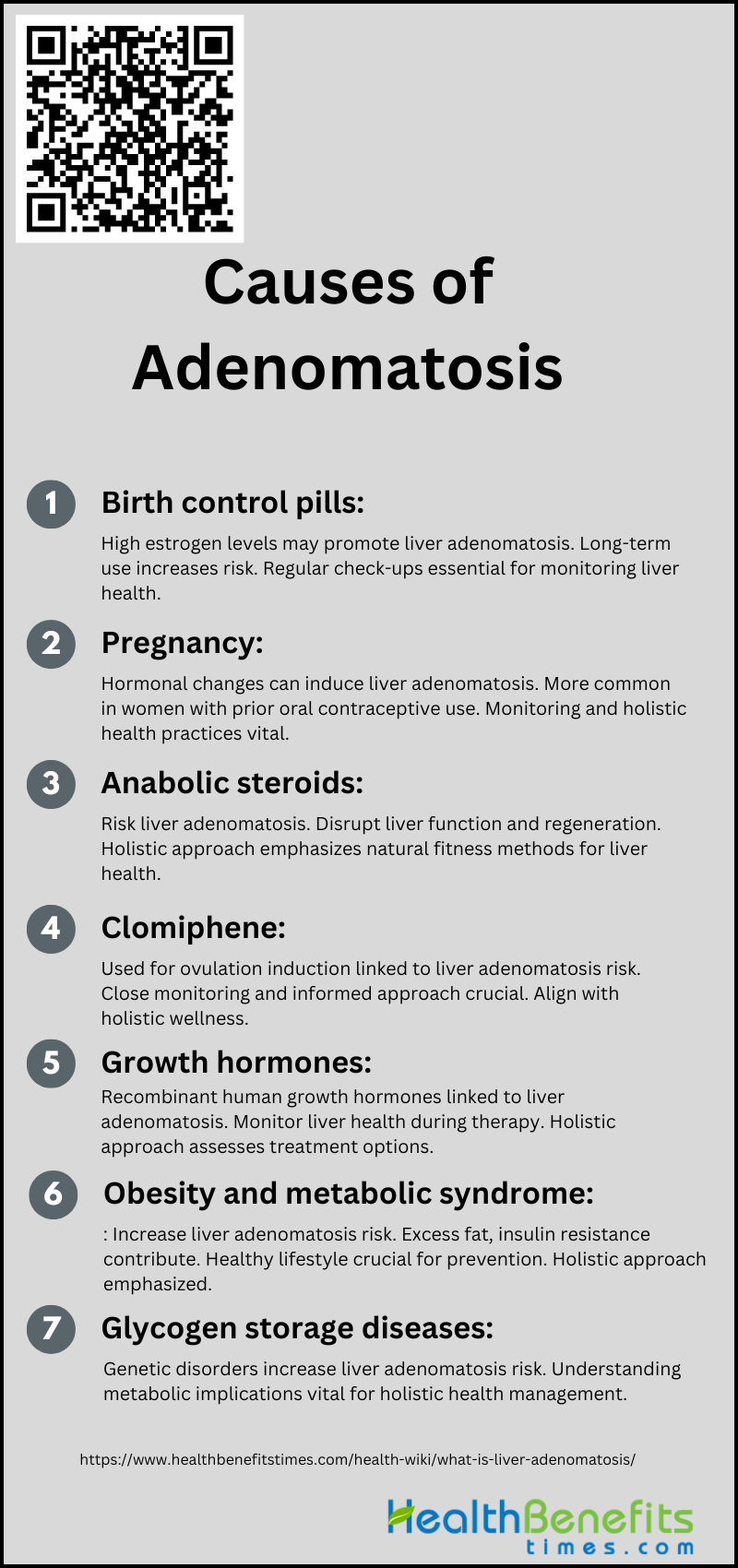
Symptoms of Liver Adenomatosis
Understanding these symptoms is crucial for early detection and effective management of the condition. Here, we explore the key signs that may indicate the presence of liver adenomatosis.
1. Sudden abdominal pain
Experiencing sudden abdominal pain can be an alarming sign of liver adenomatosis, a condition marked by benign liver tumors. This pain typically felt as a sharp or dull ache in the upper right section of the abdomen, may spread to the back or shoulder and intensify as the adenomas grow, exerting pressure on the liver or nearby tissues. Such symptoms, which can also include nausea, vomiting, and a general sense of unwellness, could indicate serious complications like adenoma rupture or bleeding, necessitating immediate medical intervention. In the realm of holistic health, fitness, and wellness, it is critical to heed these warning signs, promptly seek medical evaluation, and consider complementary therapies that support overall health objectives, underscoring the value of body awareness and proactive health management.
2. Low blood pressure
Liver adenomatosis, marked by multiple benign liver tumors, can sometimes lead to low blood pressure, especially if a tumor ruptures, causing internal bleeding and a severe drop in blood pressure. This may result in lightheadedness, dizziness, or fainting, particularly when standing up from a lying or sitting position. Such a rupture requires urgent medical care to avoid life-threatening complications. For those with liver adenomatosis, regular monitoring of blood pressure is essential, as changes could signal shifts in liver function or tumor activity. To manage blood pressure holistically, one should consider dietary changes, stress reduction, and consistent exercise alongside traditional medical treatments, and be vigilant about early detection, especially if at risk due to factors like long-term use of certain medications.
3. Internal bleeding
The development of multiple benign liver tumors, can become a critical health issue if it leads to internal bleeding, a severe complication that demands urgent medical intervention. This condition often goes unnoticed until it manifests through symptoms like intense abdominal pain, particularly in the upper right area, along with sensations of fullness, weakness, fatigue, and a sudden drop in blood pressure. These signs may signal a rupture of the adenomas and the onset of internal bleeding. Embracing a holistic health perspective, it’s vital to promptly recognize these symptoms and pursue comprehensive medical care to manage the condition and avert further risks. A holistic approach also underscores the necessity of maintaining a balanced lifestyle and consistent health checks to bolster liver function and minimize the likelihood of such critical events.
Diagnosis of Liver Adenomatosis
Understanding the intricacies of this disease is crucial for holistic health management and well-being. Below is a list of key steps and considerations in the diagnostic process of liver adenomatosis, aimed at providing clarity and guidance for those seeking comprehensive health information.
1. Ultrasound
Ultrasound imaging emerges as a key non-invasive method for the early detection of liver adenomatosis, providing essential real-time insights into the liver’s condition. By utilizing high-frequency sound waves, this technique captures images that pinpoint the size, number, and specific characteristics of benign liver tumors, known as adenomas. Its ability to distinguish between solid and liquid liver components is particularly useful in assessing the nature and scope of the disease. Not only is ultrasound imaging safe, free from radiation, and suitable for repeated use, but it also plays a vital role in guiding further diagnostic steps like biopsies, ensuring a thorough and patient-focused approach to health care. As a result, it is an invaluable asset for both initial diagnosis and continuous monitoring of liver adenomatosis within a wellness-oriented practice.
2. MRI or a CT scan
Liver adenomatosis diagnosis often relies on imaging techniques such as MRI and CT scans. MRI is particularly useful due to its ability to characterize tissue composition, revealing intratumoral fat in 80% of cases, which aids in differentiating adenomas from other lesions. MRI excels with its high contrast resolution, allowing for the precise differentiation of benign liver adenomas from other liver lesions without radiation exposure. It produces detailed images using magnetic fields and radio waves, which can be further clarified with contrast agents to assess adenomas’ characteristics. CT scans, especially dynamic enhanced ones, provide insight into the vascular nature of the tumors, showing hypervascularity in 63% of patients. CT scans complement this by using X-rays to quickly create cross-sectional images that can detect calcifications and provide an overview of liver health. Both imaging methods are integral to a comprehensive health strategy, aiding in the early detection and ongoing management of liver adenomatosis, thus contributing to the maintenance of overall liver well-being.
3. Biopsy
Accurately diagnosing liver adenomatosis is essential, and it is the biopsy that stands as the cornerstone of this process. Studies show that liver biopsy, especially when combined with immunohistochemistry, significantly improves the accuracy of subtyping hepatocellular adenomas (HCAs), which is crucial for patient management. This diagnostic procedure entails the extraction of a small liver tissue sample, either through percutaneous or surgical means, which is then rigorously analyzed under a microscope. Although modern imaging methods like ultrasound and MRI can hint at the presence of liver adenomas, only a biopsy can offer conclusive evidence by identifying the characteristic benign hepatocytes, arranged in dense cords without portal tracts or bile ducts, and sometimes showing signs of steatosis. This level of detailed examination is vital as it not only confirms the nature of the growths as benign but also steers the personalized treatment and wellness strategies crucial for managing this uncommon liver ailment.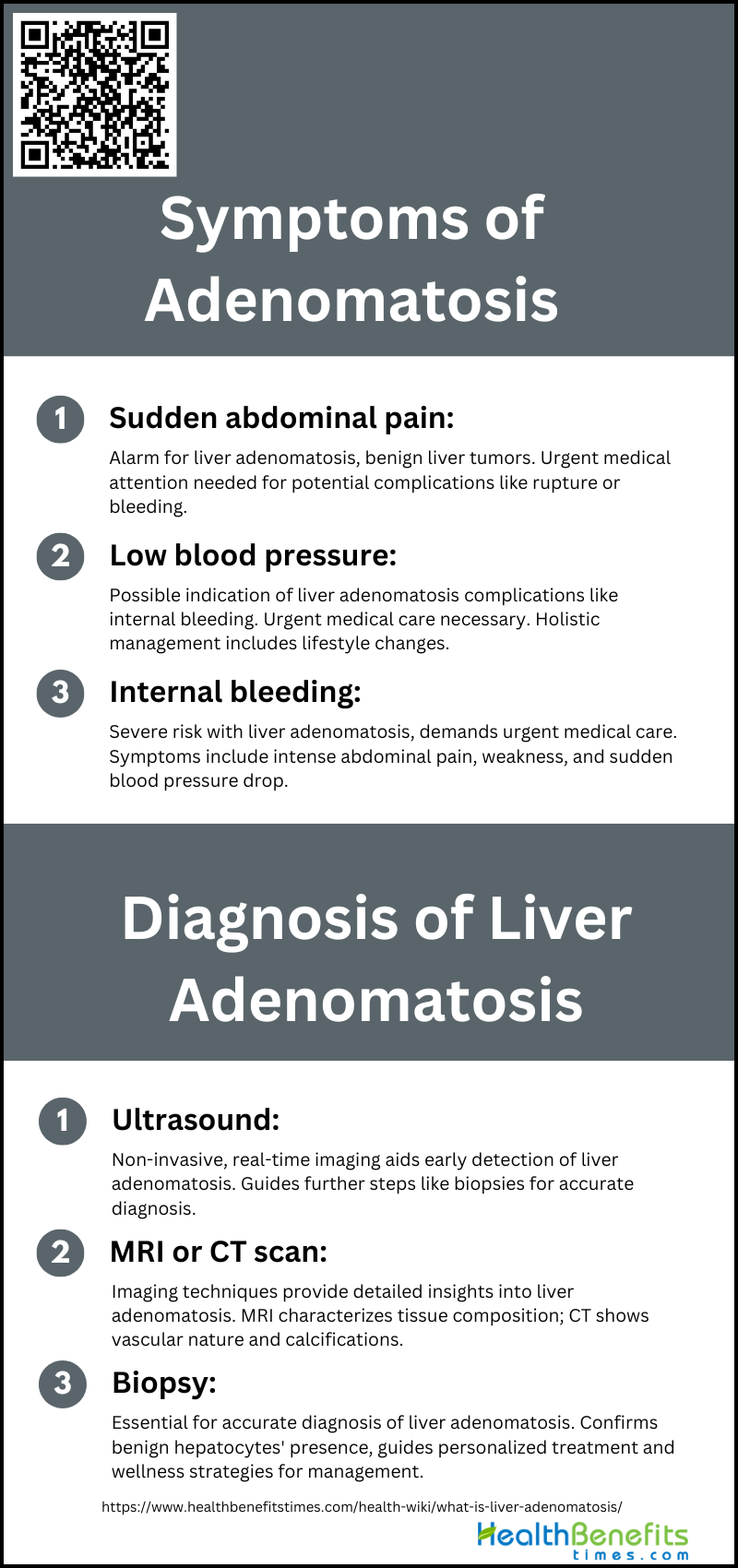
Treatment and Management of Liver Adenomatosis
Liver adenomatosis, a rare but serious condition characterized by the presence of multiple adenomas in an otherwise normal liver, poses significant challenges in diagnosis and management. Below, we present a comprehensive list of interventions aimed at supporting liver health and patient well-being in the context of liver adenomatosis.
1 Monitoring and conservative management strategies
For individuals managing liver adenomatosis, a condition marked by benign liver tumors, a holistic health approach prioritizes regular monitoring and lifestyle changes to safeguard liver health and avert complications. Regular imaging, such as ultrasounds or MRIs, is essential to observe any changes in the tumors. Embracing a diet abundant in antioxidants and anti-inflammatory foods, avoiding harmful substances like alcohol, and discontinuing certain medications can bolster liver function and curb tumor growth. Weight control through exercise and stress-reducing practices like yoga or meditation is also advantageous, considering the link between obesity, stress, and liver disease. Patients should collaborate with healthcare providers to customize a management plan that reflects their health objectives; including assessing the necessity for surgery based on the adenomas’ characteristics and personal risk factors. This conservative and proactive strategy aligns with the principles of natural and preventive care, integral to holistic health.
2. Surgical options, including resection and liver transplantation
Surgical options like resection or transplantation are considered for their ability to provide a lasting solution. Surgical management of liver adenomatosis primarily involves resection and, in severe cases, liver transplantation. Resection, which involves the removal of these tumors, is often the preferred treatment for symptomatic adenomas, those with cancerous potential, or those at risk of bleeding, particularly when they are few and easily accessible. Conversely, liver transplantation is recommended for more complex cases with multiple, large, or unfavorably located adenomas, especially when there’s a high risk of cancer development or significant liver function impairment. Both procedures not only address immediate health issues but also support a holistic health perspective by aiming to enhance long-term wellness and quality of life. These interventions should be tailored to each patient’s unique situation and are best carried out in specialized centers with expertise in liver disease.
3. Medication adjustments, particularly concerning hormonal therapies
Managing liver adenomatosis necessitates careful consideration of hormonal therapies due to their influence on adenoma growth. Patients, particularly women using estrogen-based contraceptives or hormone replacement therapy, should consult with their healthcare providers to explore safer alternatives. The objective is to reduce hormonal effects that may worsen liver adenomas, while maintaining overall health. This is a key element of a comprehensive treatment strategy that also includes lifestyle and dietary modifications, as well as supplements to bolster liver function and general well-being. Men are similarly advised to avoid anabolic steroids to decrease the risk of adenomas becoming malignant. Ultimately, these medication adjustments aim to prevent tumor progression and new tumor development, ensuring a balance between effective treatment and the patient’s holistic wellness.
Prevention and Screening for Liver Adenomatosis
It is crucial to understand the importance of preventive measures and regular screening to maintain liver health. Below, we outline key strategies and tests that can help in the early detection and management of liver adenomatosis.
1. Importance of regular imaging and health check-ups
The importance of regular imaging and health check-ups in detecting and preventing liver adenomatosis is critical for maintaining liver health and overall well-being. Liver adenomatosis, often asymptomatic and undetected in its early stages, can lead to serious health issues if adenomas bleed or become cancerous. Utilizing simple imaging methods like ultrasound, MRI, and CT scans, healthcare professionals can identify these adenomas early on. This early detection is key to timely treatment, which can prevent further complications. Health check-ups that include liver function tests and discussions with healthcare providers are equally important, as they offer personalized guidance on lifestyle choices and preventive strategies to ensure the liver’s optimal function. Integrating these health practices into a regular wellness routine is a proactive step towards safeguarding this essential organ.
2. Lifestyle modifications to reduce risk
To mitigate the risk of liver adenomatosis, lifestyle modifications play a crucial role. A healthy diet rich in plant sources, maintaining an optimal weight, and engaging in regular physical activity are key preventive measures. A balanced diet that includes plenty of fruits, vegetables, and whole grains, while minimizing processed and high-saturated fat foods, is fundamental to liver wellness. Engaging in regular exercise helps control weight and lower obesity risk, which is linked to liver issues. It’s also important to drink alcohol in moderation, avoid smoking, and limit exposure to toxins found in some medications and pollutants. For those at increased risk, such as people with a history of long-term oral contraceptive use or metabolic disorders, liver screenings may involve imaging tests. By making these health-conscious choices, individuals can actively support their liver’s function and enhance their overall well-being, embodying the essence of a holistic lifestyle.